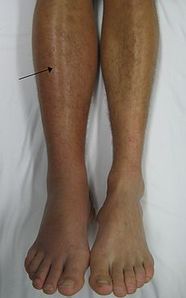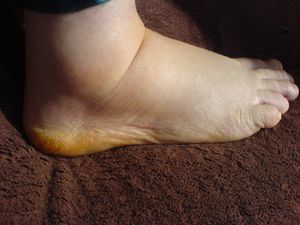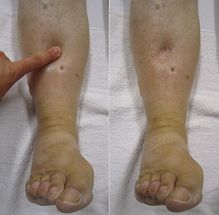Edema is defined as a palpable swelling produced by an accumulation of fluid in the intercellular tissue that results from an abnormal expansion in interstitial fluid volume.
- The fluid between the interstitial and intravascular spaces is regulated by the capillary hydrostatic pressure gradient and the oncotic pressure gradient across the capillary.
- The accumulation of fluid occurs when local or systemic conditions disrupt this equilibrium, leading to increased capillary hydrostatic pressure, increased plasma volume, decreased plasma oncotic pressure (hypoalbuminemia), increased capillary permeability, or lymphatic obstruction.
The rapid development of generalized pitting edema associated with the systemic disease requires prompt diagnosis and management.
Assessment of Edema
History - Should include:
- Timing of the edema- since when? Acute swelling of a limb over a period of less than 72 hours is more characteristic of deep venous thrombosis (DVT), cellulitis, ruptured popliteal cyst, acute compartment syndrome from trauma, or recent initiation of calcium channel blockers. The chronic accumulation of more generalized edema is due to the onset or exacerbation of chronic systemic conditions, such as congestive heart failure (CHF), renal disease, or hepatic disease.
- Changes of edema with position
- Unilateral or bilateral edema: Unilateral edema can result from DVT, venous insufficiency, venous obstruction by a tumor (e.g., tumor obstruction of the iliac vein), lymphatic obstruction (e.g., from a pelvic tumor or lymphoma), or lymphatic destruction (e.g., congenital vs. secondary from a tumor, radiation, or filariasis). Bilateral or generalized swelling suggests a systemic cause, such as CHF (especially right-sided), pulmonary hypertension, chronic renal or hepatic disease (causing hypoalbuminemia), protein-losing enteropathies, or severe malnutrition.
- Medication history and
- Assessment of systemic diseases.
Physical Examination - In physical examination, pitting, tenderness, skin changes, and temperature are evaluated.
- Pitting: There are two types of edema, pitting and non- pitting edema. Pitting edema is described as an indentation that remains in the edematous area after pressure is applied. Its location, timing, and extent are determined for treatment response. It is mainly assessed on the medial malleolus, the bony portion of the tibia, and the dorsum of the foot. Non-pitting edema is seen in lymphoedema, myxedema, and lipedema.
- Tenderness: Pain to palpation over the edematous area is associated with DVT and complex regional pain syndrome type 1 (i.e., reflex sympathetic dystrophy).In contrast, lymphoedema generally does not elicit pain with palpation
 Change in skin temperature, color, and texture: Warmth in the edematous area is associated with acute DVT and cellulitis. Redness, shinny skin, and ulcer are to be noted. Yellow-brown hemosiderin deposition is seen in venous insufficiency.
Change in skin temperature, color, and texture: Warmth in the edematous area is associated with acute DVT and cellulitis. Redness, shinny skin, and ulcer are to be noted. Yellow-brown hemosiderin deposition is seen in venous insufficiency.
Methods to Quantitatively Assess Peripheral Edema
There are various methods used in research to assess peripheral edema.
The most commonly used tools to measure edema are:
- Volume measurements (with a water volumeter)
- Girth measurements (with a tape measure).
- Pitting edema assessment (based on the depth and duration of the indentation).
Water displacement and ankle circumference had shown a high inter-examiner agreement (intraclass correlation coefficient 0.93, 0.96 right; 0.97, 0.97 left).
- Water Displacement ( Volume measurements)
The volumeter:
- Introduced into medicine by Glisson in 1622
- Utilizes the same principle of water displacement first discovered by the ancient Greek mathematician, Archimedes, which states that the water volume displaced is equal to the volume of the object immersed in the water.
- Clear acrylic rectangular box (13″x5″x9″) with a spout at the top of one of the short sides is filled with water until water rushes out of the spout. When the water level is stable, the patient places one foot in the volumeter, displaced water collected and measured in a graduated cylinder. The amount of water displaced in milliliters equals the volume of the foot/ankle or hand.
- For the ankle, a volumetry test can be done in either sitting or standing with knees 90 degrees in sitting and foot flat in the base of the volumeter.
- For the hand, the participant’s hand is placed slowly into the volumeter with forearm pronated, fingers adducted, and thumb facing the spout until the web of the middle and ring finger rested on the stop dowel of the volumeter.
Advantage - It is the gold standard tool for the measurement of edema.
Disadvantages - There are various disadvantages to these methods in a clinical setting.
- It is time taking as it has to be set up several minutes before the test as the water level needs to be stable.
- It is difficult to move once filled with water.
- It requires specialized equipments.
- It is messy as they require the patients to immerse their hands in water, and it is therefore unsuitable for certain patient populations.
2. Girth measurements (with a tape measure)
- Circumferential Method
The circumferential method is one of the girth measurement techniques. For consistent measurements, each upper extremity or lower extremity is marked with a semi-permanent marker at a certain part with reference to the bony prominences,
- Figure-of-Eight method
It is also one of the girth measurement techniques. It is more reliable than the circumferential method as it covers a bigger area. A tension-controlled measuring tape is preferred to wrap around the ankle/foot or hand for the measurement of edema than standard tape. A figure of 8 method is usually preferred in ankle and hand swelling. It has its own specific points across for consistency.
3. Pitting edema
Assessment - Press firmly with your thumb for at least 2 seconds on each extremity
- Over the dorsum of the foot
- Behind the medial malleolus
- Lower calf above the medial malleolus
Pit depth and the time needed for the skin to return to its original appearance (recovery time) are recorded.
The grading of edema is determined by pit depth (measured visually) and recovery time from grade 0-4. The scale is used to rate the severity and the scores are as follows:
- Grade 0: No clinical edema
- Grade 1: Slight pitting (2 mm depth) with no visible distortion that rebounds immediately.
- Grade 2: Somewhat deeper pit (4 mm) with no readily detectable distortion that rebounds in fewer than 15 seconds.
- Grade 3: Noticeably deep pit (6 mm) with the dependent extremity full and swollen that takes up to 30 seconds to rebound.
- Grade 4: Very deep pit (8 mm) with the dependent extremity grossly distorted that takes more than 30 seconds to rebound.
Conclusion
- Water displacement and ankle measurement more reliable methods
- Clinical assessment highly variable due to its subjective nature
Pitting Edema
- The indention recovery time (how long it takes for the indention to refill) can be helpful in determining diagnosis
- There is a direct relation between the serum albumin concentration and the indention recovery time (hypoalbuminemic edema recover time is < 40 seconds)
Focus assessment on: symmetry of swelling, pain, edema change with dependence, skin findings (hyperpigmentation, stasis dermatitis, lipodermatosclerosis, atrophie blanche, ulcerations), and history of venous thromboembolism.




0 Comments